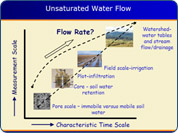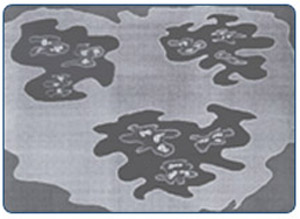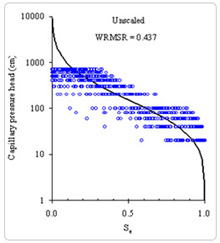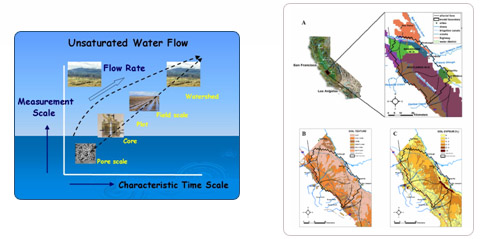 |
Soil physical properties and processes are notoriously heterogeneous, with their values depending on the spatial and time scale of interest. Specifically, the scale-dependency of soil properties and their relation to vadose zone processes of flow and transport have precluded a unifying concept of water flow and chemical transport across spatial scales, from the microscopic pore scale to the macroscopic local scale, and evolving into the field, basin, or landscape scale. Because of these inherent spatial soil heterogeneities, the outcome of a soil physical measurement is dependent on measurement volume. In addition, this sample volume effect may be affected by temporal variations of the soil property of interest. For example, sampling volume may be less a factor in the outcome of a soil moisture measurement, if a surface soil is sampled immediately after a rainfall event when the soil is uniformly wet.

Hopmans, J.W., D.R. Nielsen, and K.L. Bristow. 2002a. How Useful are Small-scale Soil Hydraulic Property Measurements for Large-scale Vadose Zone Modeling. IN, Heat and Mass Transfer in the Natural Environment, The Philip Volume. Editors: D.Smiles, P.A.C. Raats, and A. Warrick. AGU, Geophysical Monograph Series No 129. Pages 247-258. DOWNLOAD: PDF
Harter, T. and J.W. Hopmans. Role of vadose zone flow processes in regional scale hydrology: review, opportunities and challenges. IN: Unsaturated zone modeling: Progress, Challenges and Applications. Eds. R.A. Feddes, G.H. De Rooij, and J.C. van Dam. Kluwer Academic Publs. Dordrect. 2004. Pages. 179-210. DOWNLOAD: PDF
Hopmans, J.W. and G.H. Schoups. 2003. Soil water flow at different spatial scales. Encyclopedia of Hydrologic Sciences. In Press. DOWNLOAD: PDF
A. Scaling techniques
B. Spatial scaling applied to flow and transport modeling
____________________________________________________________

Most of the uncertainty in the assessment of water flow in unsaturated soils at the field scale can be attributed to soil spatial variability caused by soil heterogeneity.The exact nature of the functional dependence of both soil water retention and unsaturated hydraulic conductivity with water content differs among soil types with different particle size compositions and pore size geometry within a heterogeneous field soil. The scaling approach has been extensively used to characterize soil hydraulic spatial variability and to develop a standard methodology to assess the variability of soil hydraulic functions and their parameters. The single objective of scaling is to coalesce a set of functional relationships into a single curve using scaling factors that describe the set as a whole (e.g. structural unit). The procedure consists of using scaling factors to relate the hydraulic properties at a given location to the mean properties at an arbitrary reference point. This physically-based scaling concept provides for the simultaneous scaling of the soil water retention (Kosugi and Hopmans, 1998) and unsaturated hydraulic conductivity functions (Tuli et al., 2001), leading to scaled-mean soil hydraulic functions for each structural unit, to serve as effective soil hydraulic functions. In another paper (Nielsen et al., 1998), we present a review of successful scaling applications, and suggest alternative approaches to face new challenges in soil physics research.

References:
Tuli, A., K. Kosugi and J.W. Hopmans. 2001. Simultaneous scaling of soil water retention and unsaturated hydraulic conductivity functions assuming lognormal pore-size distribution. Adv. Water Resour. 24:677-688. DOWNLOAD: PDF
Kosugi, K., and J.W. Hopmans. 1998. Scaling water retention curves for soils with lognormal por size distribution. Soil Sci. Soc. Amer. J. 62(6):1496-1505. DOWNLOAD: PDF
Vogel, T., M. Cislerova, and J. W. Hopmans. 1991. Porous media with linearly variable soil hydraulic properties. Water Resources Research 27(10):2735-2741. DOWNLOAD: PDF
Clausnitzer, V., J. W. Hopmans, and D. R. Nielsen. 1991. Simultaneous
scaling of soil water retention and hydraulic conductivity curves. Water
Resources Research 28(1):19-31. DOWNLOAD:
PDF
Hopmans, J. W. 1987. A comparison of various methods of scale soil hydraulic
properties. Journal of Hydrology 93:241-256. DOWNLOAD:
PDF
Hopmans, J. W. 1990. Stochastic description of field-measured infiltration data. Transactions of American Society of Agricultural Engineers 32(6):1987-1993.
Nielsen, D.R., J.W. Hopmans and K. Reichardt. 1998. An emerging technology for scaling field soil water behavior. 1998. IN: Scale Dependence and Scale Invariance in Hydrology (G. Sposito, ed.). Cambridge University Press. Pages 136-166.
Clausnitzer, V., J.W. Hopmans, and J.L. Starr. 1998. Analysis of parameter estimation for infiltration models. Soil Sci. Soc. Amer. J. Vol. 62(6):1477-1487. DOWNLOAD: PDF

In my research, I continue to provide examples of successful application of scaling approaches to describe soil heterogeneity and its influence on the hydrologic regime at the field scale. This type of scaling is extremely relevant when one needs spatial information for numerical modeling purposes. For example, by applying scaling techniques as Miller-and-Miller scaling, soil spatial heterogeneity can be characterized by a single parameter, distributed in space. This so-called scaling parameter can be deterministic or stochastic.
In soil hydrological studies, soil map units may define the structural units across the landscape. This distribution or dis-aggregation of a watershed in structural units is deterministic (distributed modeling) and their aggregation to the scale of interest may be possible by simple mass conservation principles. Recent optimization algorithms now allow for multiple objective functions for multi-parameter distributed watershed modeling, with effective hydrologic parameter values determined by the choice of the most relevant hydrological variables (e.g. Vrugt et al., 2004). Stochastic approaches to upscale soil hydrological processes from the local to the regional scale include Monte-Carlo (MC) analysis. Typically, in MC analysis, numerical solutions are repeated using different realizations of spatially-variable soil hydrological properties. Realizations are generated using a random number generator from a priori knowledge of the statistical distribution of the parameter(s) in questions, including their spatial correlation. Repeated solutions will yield the stochastic information needed for the relevant output variables. An example of this approach was used by Hopmans and Stricker (1989). In this study scaling factors and soil hydraulic functions were generated for different soil map units and soil horizons to study the soil water regime in a 650-ha watershed, specifically the influence of soil heterogeneity on plant transpiration.
The inverse method offers a powerful procedure to estimate flow properties across spatial and temporal scales. Inverse methods might be especially appropriate for estimating regional-scale effective soil hydraulic parameters, from boundary condition measurements. For example, Eching et al. (1994) estimated field-representative hydraulic functions using inverse modeling with field drainage flow rate serving as the lower boundary condition for the Richards flow equation applied at the field-scale. Although the inverse method may suffer from non-uniqueness, the application of inverse methods in general to estimate soil hydraulic functions across spatial scales is very promising, yielding effective hydraulic properties that pertain to the scale of interest. Recent applications include the optimization of soil hydrological properties for hydrologic modeling at the basin scale (Schoups et al., 2004).
References:
Hopmans, J.W. and G.H. Schoups. 2003. Soil water flow at different spatial scales. Encyclopedia of Hydrologic Sciences. In Press. DOWNLOAD: PDF
Vrugt, J.A., G.H. Schoups, Jan W. Hopmans, C. Young, W.W. Wallender, T.H. Harter and W. Bouten. 2004. Inverse modeling of large-scale spatially-distributed vadose zone properties using global optimization. Water Resour. Res. 40:W06503, doi:10.1029/2003WR002706. DOWNLOAD: PDF
G.H. Schoups, Jan W. Hopmans, C. Young, J. Vrugt and W.W. Wallender, 2004. Multi-criteria optimization of a regional spatially-distributed subsurface water flow model. In Press. J. Hydrology. DOWNLOAD: PDF
Harter, T. and J.W. Hopmans. Role of vadose zone flow processes in regional scale hydrology: review, opportunities and challenges. IN: Unsaturated zone modeling: Progress, Challenges and Applications. Eds. R.A. Feddes, G.H. De Rooij, and J.C. van Dam. Kluwer Academic Publs. Dordrect. 2004. Pages. 179-210. DOWNLOAD: PDF
Hopmans, J. W. and J. N. M. Stricker. 1989. Stochastic analysis of soil water regime in a watershed. Journal of Hydrology 105:57-84. DOWNLOAD: PDF
Eching, S. O., J. W. Hopmans and W. W. Wallender. 1994. Estimation of in-situ unsaturated soil hydraulic functions from scaled cumulative drainage data. Water Resources Research 30(8):2387-2394. DOWNLOAD: PDF
Van Ommen, H. C., J. W. Hopmans, and S. E. A. T. M. Van der Zee. 1989. Prediction of solute breakthrough from scaled soil physical properties. Journal of Hydrology 105:263-273. DOWNLOAD: PDF
Hopmans, J. W., H. Schukking, and P. J. J. F. Torfs. 1988. Two-dimensional steady state unsaturated water flow in heterogeneous soils with autocorrelated soil hydraulic properties. Water Resources Research 24(12):2005-2017
Vogel, T. and J. W. Hopmans. 1992. Two-dimensional analysis of furrow irrigation. J. of Irrigation and Drainage Eng. Amer. Soc. Civil. Eng. 118(5):791-806.
Kamgar, A.A., J.W. Hopmans, W.W. Wallender and O. Wendroth. 1993. On plot size and sample number for neutron probe measurements in small field trials. Soil Sci. Vol. 156(4):213-224.
Shepard, S.G., W.W. Wallender, and J.W. Hopmans. 1993. One-point method for estimating furrow infiltration. Trans. Amer. Soc. Agric. Eng. Vol 36(2):395-404.
Toorman, A. F., J. W. Hopmans, and W. W. Wallender. 1993. Selenium transport
modeling in Kesterson Reservoir. Modeling of Geo-Biosphere Processes 1:229-252.